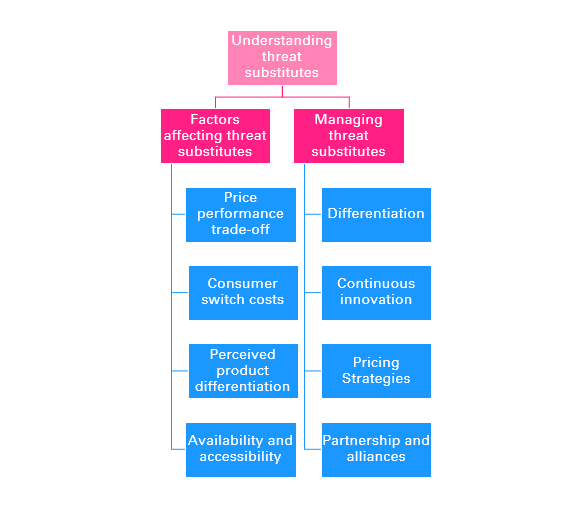In the realm of strategic management, Porter’s Five Forces framework provides a valuable tool for analyzing the competitive forces within an industry. One of the crucial forces identified by this framework is the threat of substitutes. The threat of substitutes refers to the risk posed by alternative products or services that can fulfill a similar need or offer similar benefits to consumers. Understanding this force is essential for businesses to develop effective strategies that allow them to stay competitive in their respective industries. In this blog post, we will delve into the concept of the threat of substitutes, its significance, and how businesses can respond to mitigate its impact.
Understanding the Threat of Substitutes:
The threat of substitutes is a force that influences the demand for a particular product or service. When viable alternatives exist in the market, consumers have the option to switch to those substitutes instead of the focal product. This shift in consumer preference can have a significant impact on the market share and profitability of businesses operating within the industry.

Factors Affecting the Threat of Substitutes:
Several factors contribute to the level of threat substitutes pose to a specific product or service. These include:
- Price-Performance Trade-off: If substitute products offer a better price-performance ratio compared to the focal product, consumers may be more inclined to switch. Lower prices, enhanced features, or improved quality can make substitutes more attractive.
- Consumer Switching Costs: The ease with which consumers can switch to substitutes plays a crucial role. High switching costs, such as learning new skills or investing in complementary products, can act as a barrier to substitution. Conversely, low switching costs make it easier for consumers to adopt alternative options.
- Perceived Product Differentiation: The extent to which consumers perceive the focal product as unique or differentiated affects the threat of substitutes. Strong brand loyalty and unique features can reduce the attractiveness of substitutes.
- Availability and Accessibility: The availability and accessibility of substitute products also influence their threat level. If substitutes are readily available and easily accessible, consumers may be more likely to consider them as alternatives.
Managing the Threat of Substitutes:
To effectively manage the threat of substitutes, businesses can employ several strategies:
- Differentiation: Creating a unique value proposition for the focal product can reduce the attractiveness of substitutes. By offering features, benefits, or experiences that are difficult to replicate, businesses can retain customer loyalty and reduce the likelihood of substitution.
- Continuous Innovation: By consistently investing in research and development, businesses can stay ahead of potential substitutes. Introducing new and improved products or services can make substitutes obsolete or less appealing.
- Pricing Strategies: Strategic pricing can be employed to make the focal product more competitive against substitutes. Price reductions, discounts, or bundling strategies can help maintain customer loyalty and make switching to substitutes less attractive.
- Partnerships and Alliances: Collaborating with other businesses or forming strategic alliances can strengthen a company’s position against substitutes. Joint ventures, exclusive distribution agreements, or partnerships with complementary products can enhance the overall value proposition and deter consumers from switching.
Conclusion:
The threat of substitutes is a critical component of Porter’s Five Forces analysis that businesses must carefully evaluate. Identifying and understanding the factors that contribute to the threat level allows businesses to develop effective strategies to mitigate its impact. By differentiating their products, continuously innovating, employing strategic pricing, and leveraging partnerships, businesses can minimize the likelihood of substitution and maintain a competitive edge within their industry.
Analyzing the threat of substitutes is an ongoing process as consumer preferences and market dynamics evolve. Therefore, businesses must regularly reassess the landscape, adapt their strategies, and stay attuned to emerging alternatives to effectively navigate the challenges posed by substitutes in the marketplace.